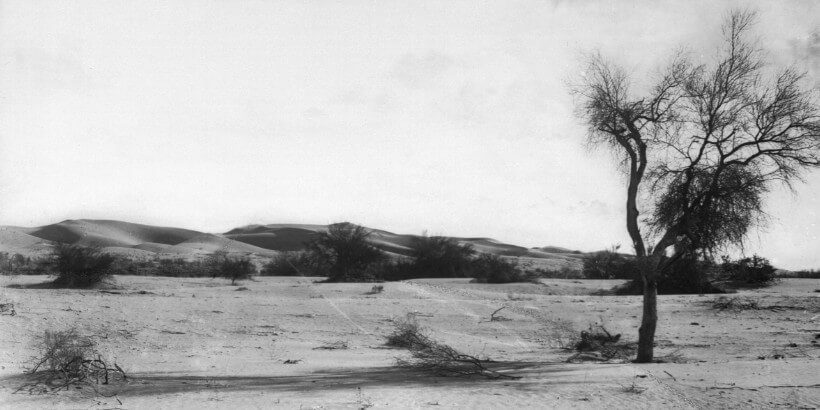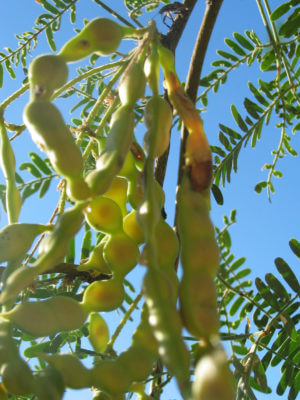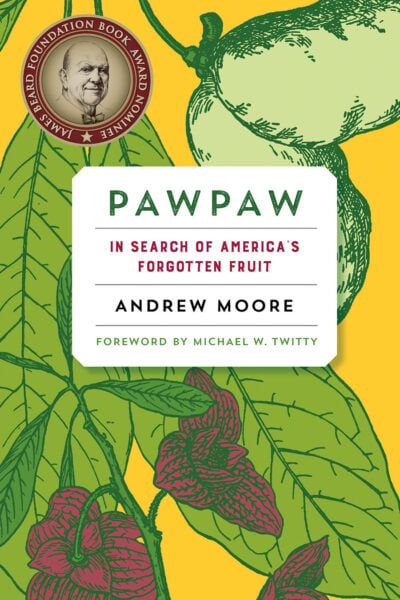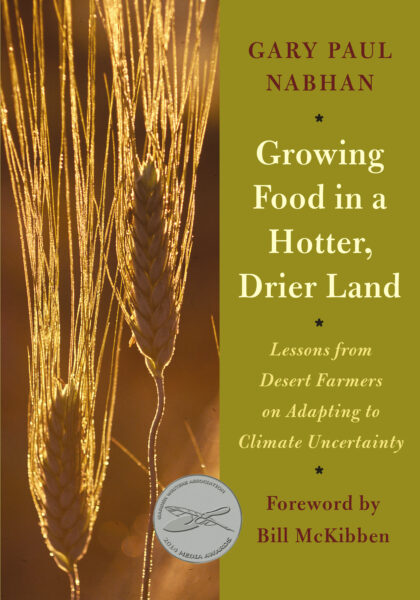Cooking with Mesquite: Ancient Nourishment

Mesquite has been a staple in desert dwellers’ diet for far longer than maize or even livestock. With its nutritional value (it’s filled with both complex carbs and protein!) and endless possibilities for preparation, it’s no wonder it was once an integral source of sustenance for such a large region. If you happen to get your hands on a few pods, be sure to make a batch of mesquite molasses – a base that can be used for so many other delicious dishes!
The following excerpt and recipe are from Mesquite by Gary Paul Nabhan. It has been adapted for the web.
From Big Bend to the Grand Canyon, there were so many accounts of mesquite pods being the principal harvests of indigenous foragers and farmers at the time of first European contact that it piqued the interest of archaeologists. The most perceptive among them began to assess their importance in the prehistoric record. On the basis of abundant evidence of mesquite remains from caves and pit houses, paleo-nutritionists like Vaughn Bryant confirmed that mesquite beans have been a staple for North Americans for far more generations than have cultivated maize or raised grass-fed beef. But most contemporary citizens of North America can hardly imagine that a wild food was more important than a domesticated livestock species or cultivated crop for all but the last four hundred years of human history here.
In fact, mesquite was the mainstay for most of those folks, not the appetizer or dessert. The first nine-tenths of all human generations that have lived in the Americas have been hunter-gatherers who relied more on wild resources such as mesquite than on cultivated crops or livestock. Only during the last century, as the daily use of mesquite began to wane, did ethnobotanists have to remind our citizenry that mesquite was the chief source of wild food, “the staple of life”—the main source of both complex carbohydrates and proteins sourced in the desert borderlands. If mesquite species with sweet, edible pods cover more than 1.6 million square miles of North American soil, that means that they were likely the nutritional mainstay for people in an area half the size of the contiguous United States. The native peoples of what we now call the desert borderlands—from the Californias to the Gulf Stream waters—relied upon mesquite foods prehistorically and historically for their sustenance.
My main-squeeze-of-a-tree was not only hot stuff, but big stuff, strutting around all the way from the Gulf of Mexico to the Gulf of California. You know, from sea to shining sea.
Recipe: Mesquite Molasses
Melaza de la Péchita del Mezquite / Dibs bi al-Kharoub Amriki
Yield: 2.5 to 3 pints
Once you recognize that mesquite pods are essentially the New World analog of the pods of carob (also known as locust or St. John’s bread), you can begin to adapt dozens of delicious Middle Eastern and North African recipes to mesquite pods. Most of these call for use of pod fragments in infusions or for toasted pods ground into a fine powderlike flour. The Arabic term for carob pods of the tree Ceratonia siliqua is al-kharoub. It gave rise to the ancient Latin carrubium, which was Hispanicized as algarroba and Anglicized as carob. Mesquites (not just carob trees) are still called algarroba in most of South America and in regions of Mexico as well.

For the infused broth (makes 4 or 5 cups):
18 cups of water
6 cups dried mesquite pods (about 48 ounces), cracked into 2-inch fragments
1 teaspoon coarsely ground sea salt or kosher salt
For the molasses:
3 cups clarified, infused mesquite broth (from above)
1⁄3 of a 1.7–2.0 ounce packet of powdered pectin (or 1 cup powdered tejocote, dried Mexican hawthorn fruit)
4 cups raw turbinado sugar (or 4 tablespoons dried, powdered stevia leaves)
4 tablespoons sour orange or lime juice
Olive oil, as needed
Procedure
- Begin by making a simple infusion of the dried, cracked mesquite pods in water. Place the water in a large nonreactive pot, add the mesquite pod pieces, and bring to a boil. Reduce the heat, and simmer the mixture for an hour, skimming off any froth and fibrous pieces of the pods. Add the salt and stir to dissolve.
- Strain through a long-handled colander, wire-mesh strainer, or a cheesecloth bag, catching and disposing of the remaining pod fiber and mushy meal, while retaining the somewhat translucent, slightly opaque infused broth. Pour into a 1-gallon glass jar, cap, and cool in a refrigerator or on ice in a sink for an hour. Gently pour into jars through a finer mesh strainer, catching any remaining sediment or dregs of the solids in the screen and keeping the flavorful amber liquid.
- To make the molasses, place 3 cups of this clarified, infused broth in a nonreactive saucepan with the powdered pectin or hawthorn powder. Slowly bring to a boil, stirring constantly with a wooden spoon, while adding turbinado sugar (or stevia powder) and the citrus juice of your choice. After the mixture has boiled for 2 minutes, pour into hot, sterilized glass jars, top with 1⁄8 inch of olive oil, and seal the lids. Place the jars on a towel and let cool in a refrigerator, where the slightly tangy syrup will thicken.
- Use as a glaze, as a syrup over shaved ice, in spritzers of one-fifth molasses and four-fifths fizzy water, or in the Mesquite Molasses– Tahini Dipping Sauce (see page 180) to serve with pita bread, crackers, or bagel chips.
Recent Articles
Garlic mustard: while known as “invasive,” this plant can be consumed in its entirety and has great nutritional value. Plus, the garlic-flavor is a perfect addition to any recipe that calls for mustard! The following are excerpts from Beyond the War on Invasive Species by Tao Orion and The Wild Wisdom of Weeds by Katrina…
Read MoreOh, honeysuckle…how we love thee. If only there was a way to capture the sweet essence of this plant so we could enjoy it more than just in passing. Luckily, foraging and some preparation can help make that happen! Here’s a springtime recipe that tastes exactly like honeysuckle smells. The following excerpt is from Forage,…
Read MoreIntroducing…your new favorite brunch dish! This whole broccoli frittata is packed with fresh, wildcrafted flavors that are bound to help you start your day off on the right foot. The following is an excerpt from The Forager Chef’s Book of Flora by Alan Bergo. It has been adapted for the web. RECIPE: Whole Broccoli Frittata…
Read MoreWondering where to forage for greens this spring? Look no further than hedges, which serve as natural havens for wild greens and herbs! The following is an excerpt from Hedgelands by Christopher Hart. It has been adapted for the web. Food from Hedges: Salads and Greens Let’s start by looking at all the wild foods…
Read MoreThere’s a whole new world out there when it comes to koji. It doesn’t matter if you’re making bread, cheese, or ice cream, koji helps you pump up the flavor! Growing Koji in Your Own Kitchen Koji, the microbe behind the delicious, umami flavors of soy sauce, miso, fermented bean sauce, and so many of…
Read More







